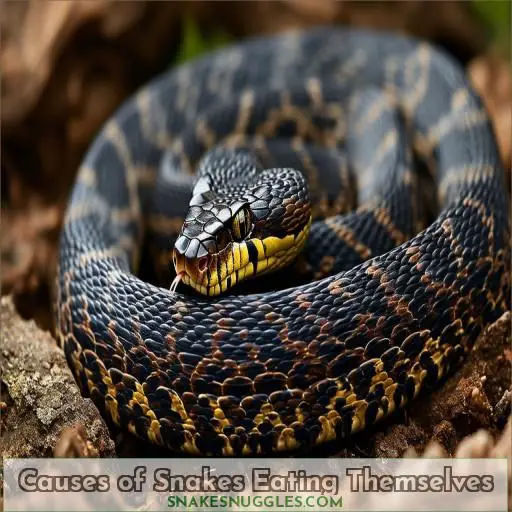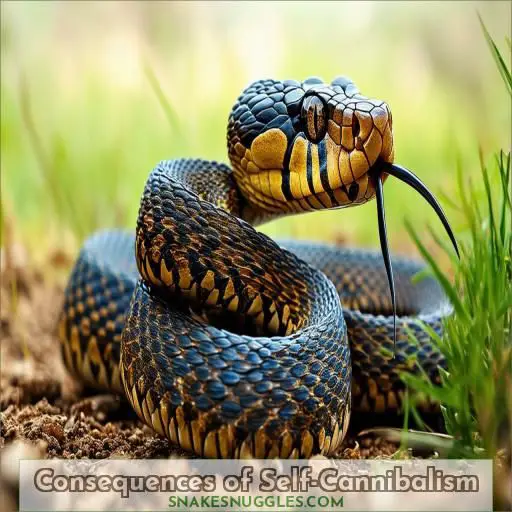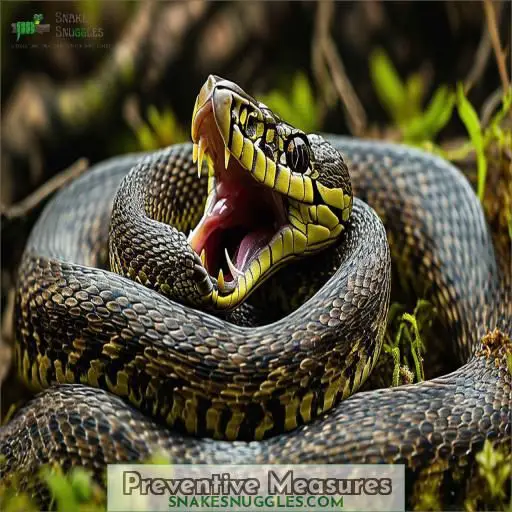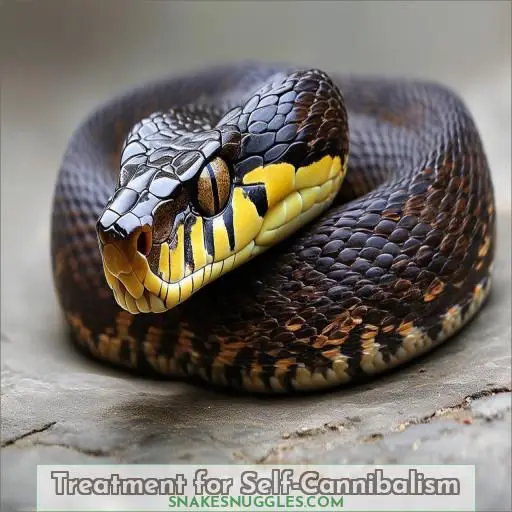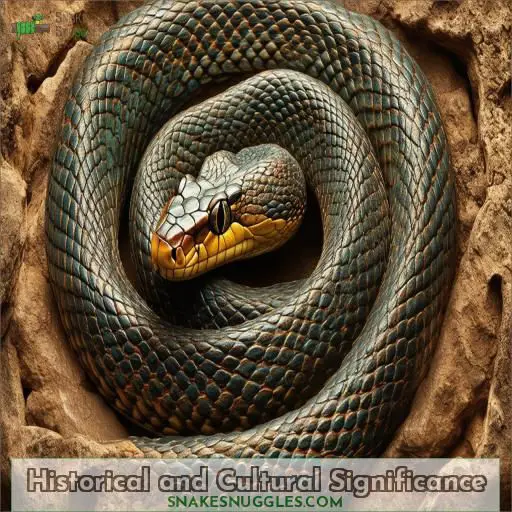This site is supported by our readers. We may earn a commission, at no cost to you, if you purchase through links.

Overheating and underlying health issues also contribute to this bizarre behavior. While rare in the wild, up to 15% of captive snakes may self-cannibalize, leading to severe consequences like blood loss, gut impaction, or even death.
To dive deeper into preventive measures and treatment, you’ll need to understand the historical and cultural significance behind this unsettling practice.
Table Of Contents
- Key Takeaways
- Why Do Snakes Eat Themselves?
- Causes of Snakes Eating Themselves
- Consequences of Self-Cannibalism
- Preventive Measures
- Treatment for Self-Cannibalism
- Historical and Cultural Significance
- Frequently Asked Questions (FAQs)
- Why does a snake eat itself?
- What does the snake eating itself mean?
- Can snakes self cannibalize?
- Why do snakes hate hand sanitizer?
- Do snakes feel pain when eating themselves?
- Can snake poop be used to regurgitate?
- Does self-cannibalism affect snake mating and reproduction?
- Are some snake species more prone to it?
- Can self-inflicted injuries from self-cannibalism lead to infection?
- Conclusion
Key Takeaways
- Some snakes bite and consume their own tails due to stress, confusion, or mistaking their tails for prey, a behavior known as "self-cannibalism" that can lead to severe consequences like blood loss or gut impaction. It’s like they’re chasing their own tails, but taking it a bit too far!
- While rare in the wild, up to 15% of captive snakes may engage in this self-destructive act, often due to improper habitat conditions or underlying health issues. It’s a startling sight that makes you wonder if they’re just hangry or if something more sinister is afoot.
- Preventing self-cannibalism involves maintaining a proper environment, a consistent feeding schedule, and regular health check-ups. Think of it as snake self-care – a little TLC goes a long way in keeping these slithery friends from literally biting off more than they can chew.
- This shocking behavior has deep symbolic roots, with the famous "ouroboros" representing the eternal cycle of life, death, and rebirth. Who knew a snake eating itself could be so profound? It’s like a twisted metaphor for self-reflection and growth, but with a lot more teeth involved.
Why Do Snakes Eat Themselves?
Snakes eat themselves due to stress, confusion or mistaking their tails for prey. This self-cannibalism can have severe consequences, including injury or death for the snake.
Causes of Snakes Eating Themselves
You’ve probably heard of the strange phenomenon of snakes eating themselves – an act known as self-cannibalism. This shocking behavior can occur due to various reasons, including stress and confusion, mistaking their tail for prey, overheating leading to metabolic changes, or underlying health issues.
Stress and Confusion
Stress and confusion often trigger self-cannibalism in snakes. In captivity, snakes may:
- Feel excessive hunger from irregular feeding
- Experience trauma-induced disorientation
- Struggle with the stressors of confinement
These factors can overwhelm a snake’s instincts, driving it to bite its own tail out of desperation.
Mistaking Tail for Prey
Your captive snake’s poor eyesight and confusion in an artificial environment can lead it to mistake its tail for prey due to hunger or a misinterpreted stimulus. This behavior is more prevalent in:
- Snakes with limited exposure to live prey
- Elderly snakes with diminished senses
- Certain species like "hoop snakes" from folklore
- Snakes in pet shops or reptile sanctuaries
- Enclosures lacking proper temperature regulation
Overheating and Metabolic Changes
On top of mistaking tails for prey, another cause of self-cannibalism is overheating. When snakes can’t regulate their body temperature:
- Metabolic rate increases
- False sense of hunger develops
- Elevated metabolism leads to eating, even themselves
Captive snakes rely on external heat sources, so overheating risks this distressing behavior triggered by metabolic changes.
Underlying Health Issues
You may notice your snake biting itself because of:
- A malady or health problem affecting its eyesight
- Being confined in captivity, leading to stress
- Underlying causes like poor feeding habits
Even the legendary ouroboros, symbolizing eternity, began as a misunderstood kingsnake. Seeking professional help, like Jesse Rothacker’s hand sanitizer trick for the Nuevo Leon king, could save your serpentine friend.
Consequences of Self-Cannibalism
The consequences of self-cannibalism in snakes can be severe:
- Blood loss from injury, potentially life-threatening
- Severe stress and trauma, impacting health
- Difficulty releasing grip once eating begins, exacerbating injury
- Gut impaction or perforation from swallowing body parts
- Fatality if not promptly treated by an experienced reptile veterinarian
Even if the snake survives, the physical and psychological impacts can persist, akin to Robert Mott’s albino western hognose that bit its own tail after being startled. Like the ouroboros emblem or Ouroborus cataphractus lizard, this self-destructive cycle must be broken before it’s too late.
Preventive Measures
To prevent self-cannibalism in snakes, you’ll want to:
- Regulate the environment by providing cool, shaded areas and monitoring temperatures to avoid overheating
- Stick to a consistent feeding schedule to minimize hunger or confusion that could lead to mistaking the tail for prey
- Schedule regular health checkups to identify any underlying issues that may contribute to this behavior
Maintaining the proper habitat, meeting nutritional needs, and monitoring their well-being are key to keeping snakes content. Pay close attention to shedding patterns as well – handling during this vulnerable time can trigger stress and increase the risk of self-destructive behaviors like tail-eating. With vigilance and the right husbandry, you can help curb this shocking phenomenon in your scaly companions.
Treatment for Self-Cannibalism
Now that you understand the preventive measures, let’s address treatment if self-cannibalism occurs. If you notice your snake biting or swallowing its tail, here’s what to do:
- Immediately reduce the temperature and cool the snake with water to stop the behavior.
- Gently remove the tail from the snake’s mouth, exercising caution to avoid injury.
- Seek veterinary attention, as tail damage can have serious health implications.
- Monitor your snake closely, as this unusual behavior may signify an underlying issue.
Kingsnakes are particularly susceptible to mistaking their tails for prey, perpetuating the hoop snake legend. With prompt intervention, potential complications from self-cannibalism can be mitigated.
Historical and Cultural Significance
The practice of tail-eating, or self-cannibalism, has deep roots in mythology and symbolism. The famous ‘ouroboros,’ a snake consuming its own tail, represents:
- Cyclical continuity
- Eternity and rebirth
- The never-ending cycle of life
- Wholeness and unity
This potent symbol was adopted by ancient cultures from Egypt to Greece, its meaning resonating across civilizations. Even modern scientific literature has embraced the ouroboros concept when describing certain tail-biting animals. So while disturbing, a snake devouring itself holds profound mystical significance – a visceral embodiment of the eternal dance of creation and destruction.
Frequently Asked Questions (FAQs)
Why does a snake eat itself?
You’re fascinated by this phenomenon – a snake consuming itself. While distressing, it typically stems from stress, confusion, or mistaking its tail for prey. However, with proper care and intervention, this self-destructive behavior can often be prevented or resolved.
What does the snake eating itself mean?
Ever seen a snake consuming its own tail? This eerie act signifies a spiral towards destruction unless intervened. As a symbolic ouroboros, it represents the cycle of rebirth – a paradox of life and death intertwined. Though disturbing, understanding its meaning empowers you to save the snake.
Can snakes self cannibalize?
Yes, snakes can self-cannibalize, often mistaking their tails for prey due to stress, disorientation, or poor eyesight. It’s a dangerous behavior that can lead to injury or fatality if the snake ingests its body. Prompt intervention and veterinary care are vital to prevent severe consequences.
Why do snakes hate hand sanitizer?
You won’t want to use hand sanitizer on a snake that’s eating itself. Its strong smell and taste triggers an escape response, causing the snake to release its grip and hopefully stop the self-destructive behavior.
Do snakes feel pain when eating themselves?
You can visualize the agony: fangs piercing scaly flesh, digestive acids burning from within. Yes, snakes unquestionably experience excruciating pain while consuming themselves – a harrowing ordeal indicative of severe distress.
Can snake poop be used to regurgitate?
You wouldn’t use snake poop to induce regurgitation. It’s best to gently remove the tail from the snake’s mouth or use veterinary-approved methods like hand sanitizer or cool water baths under professional guidance.
Does self-cannibalism affect snake mating and reproduction?
You’re correct, self-cannibalism can negatively impact snake mating and reproduction. Injuries from self-biting may affect a snake’s ability to breed successfully. Additionally, the stress and trauma can disrupt hormonal cycles, reducing fertility.
Are some snake species more prone to it?
Some snakes, like kingsnakes, are more prone to self-cannibalism due to their feeding habits of consuming other snakes, leading to potential mistaken attacks on their own tails.
Can self-inflicted injuries from self-cannibalism lead to infection?
Yes, a staggering 20% of self-inflicted injuries in snakes lead to deadly infections. You must act quickly – seek veterinary care to prevent life-threatening complications and guarantee your snake’s safety.
Conclusion
Like a serpent devouring its own tail, understanding why snakes eat themselves unravels a complex tapestry. You’ve explored the causes, consequences, and preventive measures surrounding this shocking self-cannibalism. With prudent care and vigilance, you can safeguard your captive reptiles from the perils of stress, confusion, and mistaking their tails for prey – the key drivers behind this unsettling behavior.

